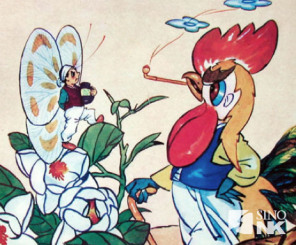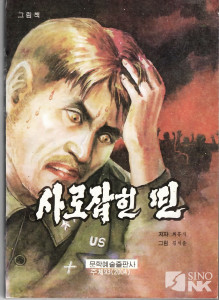
Illustration from “The Butterfly and the Cock” | Image: Christopher Richardson
“The Book is a silent teacher and companion in life.”
Kim Il Sung
In case you’d never thought of it (and I hadn’t), something by Christopher Richardson in Sino NK on Children’s Literature in North Korea. Framing his article with a lovely quote from Plato,
We shall persuade mothers and nurses to tell our chosen stories to their children, and by means of them to mold their minds and characters which are more important than their bodies….
Richardson goes on to (in the words of the editor):
Children’s literature is more than just for kids, suggests Christopher Richardson, doctoral candidate at the University of Sydney, whose research focuses on the contemporary conceptions and experiences of childhood in the DPRK. In part one of a two-part series on children’s literature in North Korea, Richardson reviews the ideological significance of the stories that all North Korean children love. —
Christopher notes that Korean’s children is surprisingly humorous and diverse (including Science Fiction), because “As Gabroussenko writes, “the literary form has traditionally served as a sweet coating for the bitter or dull medicine of North Korean propaganda,”[9] and this is perhaps most colorfully true of literature for children.”
 Christopher does also note that it is homogenously anti-American as in “A trite zoological morality play, Butterfly and Cock, depicts a large “bad tempered” rooster, bullying its neighbors, yet outwitted by a small virtuous butterfly, in an unsubtle analogy for North Korea’s existential struggle with the United States of America. In addition, Korean literature concerns the lives and exploits of its leaders, especially Kim Il-sung and Kim Jong-il, although increasingly Kim Jong-un also. Even when written for children, such tracts and treatises are written in the awed tone of religious hagiography, and indeed their strength derives from the reverent consistency of their voice and style.”
Christopher does also note that it is homogenously anti-American as in “A trite zoological morality play, Butterfly and Cock, depicts a large “bad tempered” rooster, bullying its neighbors, yet outwitted by a small virtuous butterfly, in an unsubtle analogy for North Korea’s existential struggle with the United States of America. In addition, Korean literature concerns the lives and exploits of its leaders, especially Kim Il-sung and Kim Jong-il, although increasingly Kim Jong-un also. Even when written for children, such tracts and treatises are written in the awed tone of religious hagiography, and indeed their strength derives from the reverent consistency of their voice and style.”
I take that last bit, “reverent consistency of their voice and style,” to mean boring and predictable, but I suppose if you like Juche as a philosophy, you might love Korean literature as an art form.^^
The illustration style can be awesome as the examples Christopher provides demonstrate.
Still, the article shows North Korean children’s literature as substantially broader than I would have expected, and while academically strict, is also fun to read.
North Korean children’s literature: Just the thing to put the kiddies to sleep!^^


